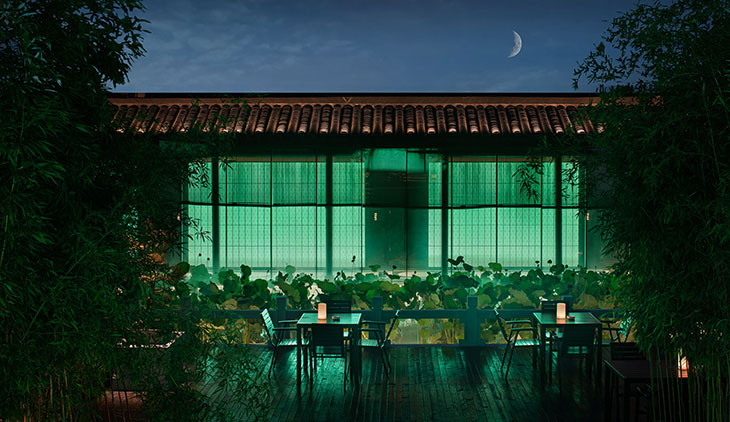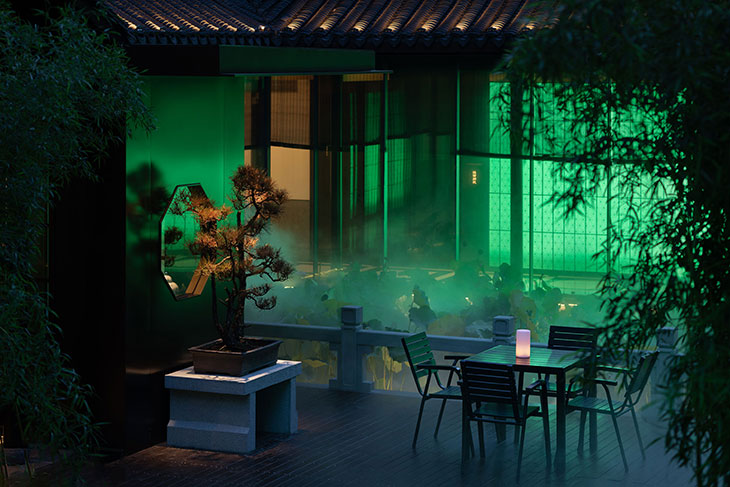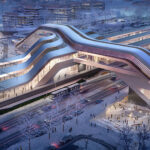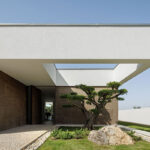
Located near Hangzhou’s famed West Lake in China’s Zhejiang Province, the Purple Garden Restaurant is a prime example of blending tradition with modernity. Designed by LDP’s Lead Designer Lei Jian, the restaurant draws inspiration from Ming Dynasty Jiangnan gardens, creating a refined atmosphere for exceptional Hunan-style cuisine. By addressing the site’s initial flooding issues with a courtyard pond filled with lotus flowers and koi fish, Lei Jian turned a challenge into a serene, oasis-like feature that enhances the dining experience.
Lei Jian’s design extends to the exterior, where the restaurant occupies a T-shaped site with distinct outdoor spaces, including a lotus pond, bamboo fences, and a century-old camphor tree. These elements create a tranquil environment, perfect for relaxation and socializing. The interior features high-ceiling private dining rooms adjacent to the lotus pond, inspired by Song Dynasty aesthetics and equipped for traditional tea ceremonies.
INTERVIEWS
In this interview by editor Anastasija Pavic, Lei Jian discusses the design process behind the Purple Garden Restaurant. Through thoughtful design choices, the restaurant offers a unique dining experience that honors tradition while embracing contemporary elegance.
What unique design challenges did you face when adapting the traditional elements of Ming Dynasty gardens for a modern restaurant setting?
Firstly, we placed a high importance on restoring as much of the existing building’s structure as possible, preserving the traditional-style bricks, tiles, and columns, as well as the spatial relationship between the structure and the garden. Following that, our task was to find a design language which had its basis in traditional architectural elements, colors, materiality, etc., but transformed and refined them into something recognizably contemporary. Our design process is in some ways similar to creating an oil painting: we constantly look closely at the canvas, take steps back to see it from afar, and repeat the process until the final image manifests itself.

How did the concept of water and lotus-themed elements influence the overall atmosphere of the restaurant?
For this project, the water and flowers are more a logical expression of our larger design intent. Water creates mist and fog, and the poetic feeling of seeing lotus flowers in the mist of the West Lake is the atmosphere we wanted to capture, the most beautiful encapsulation of Jiangnan aesthetics.
What were the key considerations in creating the four distinct outdoor spaces?
The four outdoor spaces are connected to each other in such a way that we hope that when guests pass through them, they will recognize a sense of subtly changing rhythm through the variations in materials, scales, and functions, providing a rich, diverse spatial experience.
What design strategies did you employ to ensure the courtyard landscape flows naturally into the restaurant’s interior spaces?
The first, most direct design method we used to achieve a strong relationship between the interior spaces and the courtyard was through the ‘borrowing’ of scenery: private dining rooms have been organized around the courtyard landscape, allowing it to be visually accessible from a variety of different perspectives. For interior spaces without direct views to the courtyard, we have introduced art and installations which incorporate flowers – the majority of whose materials match those of the outdoor landscape, in order to achieve an aesthetic continuity.

What considerations went into incorporating the century-old camphor tree into the landscape design?
In a word, time. As this is a restaurant with a Ming Dynasty structure, the coexistence of ancient and modern elements is most naturally associated with time. For us, it was logical that the century-old tree was the focus of the courtyard landscape, as it is the best witness of the passage of time.
Can you elaborate on the role of the tea ceremony in the restaurant’s concept?
Our first consideration was the taste and fragrance of freshly brewed tea: in a corner of the space, we have provided a place where the smell of green tea is prepared and allowed to waft through so that guests are greeted with its memorable fragrance upon entering the restaurant.
The second consideration was etiquette: tea is the traditional Chinese way of entertaining guests, and both Zhejiang and Hunan provinces are famous in China for their tea. Brewing tea is like symbolically blending the cultures of these two places, and then tasting the resulting flavors.

What inspired the decision to place the private dining rooms next to the lotus pond?
There is an old saying in Chinese which states that “rain and dew are equally distributed”. Following that, we have simply distributed views of the landscape to each private room as much as was possible, in the knowledge that appreciating it from various angles would arouse different sensations and feelings.
In what ways was traditional art incorporated into the design of the private dining spaces?
As evoking the feeling and concept of time was important in this project, traditional art is akin to an aged pocket watch which can turn one’s thoughts back in time to a bygone era. The feelings of contrast and variance provoked by using contemporary materials or modern framing techniques is also something we wanted to convey to guests of the restaurant.

What inspired the use of dyed silk walls and the specific color palette in the interior design?
It was actually my son, who brought back a silkworm from his kindergarten, and we watched it hatch from an egg and eventually become a moth. It all happened coincidentally while we were searching for fabrics for the project, and it became an inspiration. Silk is a common fabric here, but it’s usually used for clothing or accessories. The green and blue we chose were taken from the shades of lotus leaves, and blue lotus flowers, respectively.

What design features make the Purple Garden Restaurant stand out as a unique dining destination in Hangzhou?
Firstly, the quality of the dishes here is excellent. One of the most difficult aspects to control for a cross-regional restaurant is the daily supply of fresh, authentic ingredients, which this particular restaurant achieves through an efficient supply chain. At the same time, the restaurant’s head chef is also well-known as an excellent proponent of Hunan cuisine. Additionally, there is the relative scarcity of quality restaurant environments in the local district – most of the restaurants with courtyards in Hangzhou are concentrated in touristy scenic spots, while this one is located in the city center, giving customers an alternative choice. So our design, with its integrated cultural concept and careful attention to aesthetics, scale, texture, landscape, and light, is intended to provide guests with a truly memorable dining experience in the heart of the city.




